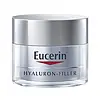What's inside
What's inside
 Key Ingredients
Key Ingredients

 Benefits
Benefits

 Concerns
Concerns

 Ingredients Side-by-side
Ingredients Side-by-side

Water
Skin ConditioningGlycerin
HumectantCoco-Caprylate/Caprate
EmollientPPG-24-Glycereth-24
EmulsifyingNiacinamide
SmoothingButylene Glycol
Humectant1,2-Hexanediol
Skin ConditioningSodium Acrylates Crosspolymer-2
AbsorbentC18-36 Acid Triglyceride
EmollientSodium Polyacryloyldimethyl Taurate
Emulsion StabilisingHydroxyacetophenone
AntioxidantJojoba Esters
EmollientOlive Oil Decyl Esters
Phytosterols
Skin ConditioningCornus Officinalis Fruit Extract
Skin ConditioningHydrolyzed Wheat Flour
Skin ConditioningSodium Mannose Phosphate
HumectantPhytosteryl Macadamiate
Skin ConditioningHydrolyzed Beta-Glucan
Skin ConditioningMimosa Tenuiflora Bark Extract
Skin ProtectingIlex Paraguariensis Leaf Extract
PerfumingSea Salt
AbrasiveFerula Galbaniflua Resin Oil
AntimicrobialHelianthus Annuus Seed Oil
EmollientCitrus Aurantium Bergamia Fruit Extract
Skin ConditioningCitrus Aurantium Dulcis Peel Oil
MaskingJuniperus Virginiana Oil
MaskingPelargonium Graveolens Flower Oil
MaskingVetiveria Zizanoides Root Oil
MaskingPrunus Amygdalus Amara Kernel Oil
MaskingChlorella Vulgaris Extract
Skin ConditioningDipteryx Odorata Seed Extract
MaskingLactic Acid
BufferingBentonite
AbsorbentC12-18 Acid Triglyceride
EmollientSqualene
EmollientTocopherol
AntioxidantSodium Acetylated Hyaluronate
HumectantMannose
HumectantCitric Acid
BufferingHydrated Silica
AbrasiveSodium Benzoate
MaskingPotassium Sorbate
PreservativeCitronellol
PerfumingGeraniol
PerfumingCoumarin
PerfumingLinalool
PerfumingLimonene
PerfumingWater, Glycerin, Coco-Caprylate/Caprate, PPG-24-Glycereth-24, Niacinamide, Butylene Glycol, 1,2-Hexanediol, Sodium Acrylates Crosspolymer-2, C18-36 Acid Triglyceride, Sodium Polyacryloyldimethyl Taurate, Hydroxyacetophenone, Jojoba Esters, Olive Oil Decyl Esters, Phytosterols, Cornus Officinalis Fruit Extract, Hydrolyzed Wheat Flour, Sodium Mannose Phosphate, Phytosteryl Macadamiate, Hydrolyzed Beta-Glucan, Mimosa Tenuiflora Bark Extract, Ilex Paraguariensis Leaf Extract, Sea Salt, Ferula Galbaniflua Resin Oil, Helianthus Annuus Seed Oil, Citrus Aurantium Bergamia Fruit Extract, Citrus Aurantium Dulcis Peel Oil, Juniperus Virginiana Oil, Pelargonium Graveolens Flower Oil, Vetiveria Zizanoides Root Oil, Prunus Amygdalus Amara Kernel Oil, Chlorella Vulgaris Extract, Dipteryx Odorata Seed Extract, Lactic Acid, Bentonite, C12-18 Acid Triglyceride, Squalene, Tocopherol, Sodium Acetylated Hyaluronate, Mannose, Citric Acid, Hydrated Silica, Sodium Benzoate, Potassium Sorbate, Citronellol, Geraniol, Coumarin, Linalool, Limonene
Water
Skin ConditioningGlycerin
HumectantButyrospermum Parkii Butter
Skin ConditioningIsopropyl Palmitate
EmollientPanthenol
Skin ConditioningCaprylic/Capric Triglyceride
MaskingHydrogenated Coco-Glycerides
EmollientOctyldodecanol
EmollientButylene Glycol
HumectantGlyceryl Stearate Citrate
EmollientStearyl Alcohol
EmollientCetyl Alcohol
EmollientGlycine Soja Germ Extract
EmollientSodium Hyaluronate
HumectantTocopherol
AntioxidantMethyl Methacrylate Crosspolymer
Acrylates/C10-30 Alkyl Acrylate Crosspolymer
Emulsion StabilisingDimethicone
EmollientCarbomer
Emulsion StabilisingCaprylyl Glycol
EmollientTrisodium EDTA
1,2-Hexanediol
Skin ConditioningPhenoxyethanol
PreservativeParfum
MaskingWater, Glycerin, Butyrospermum Parkii Butter, Isopropyl Palmitate, Panthenol, Caprylic/Capric Triglyceride, Hydrogenated Coco-Glycerides, Octyldodecanol, Butylene Glycol, Glyceryl Stearate Citrate, Stearyl Alcohol, Cetyl Alcohol, Glycine Soja Germ Extract, Sodium Hyaluronate, Tocopherol, Methyl Methacrylate Crosspolymer, Acrylates/C10-30 Alkyl Acrylate Crosspolymer, Dimethicone, Carbomer, Caprylyl Glycol, Trisodium EDTA, 1,2-Hexanediol, Phenoxyethanol, Parfum
 Reviews
Reviews

Alternatives
Ingredients Explained
These ingredients are found in both products.
Ingredients higher up in an ingredient list are typically present in a larger amount.
1,2-Hexanediol is a synthetic liquid and another multi-functional powerhouse.
It is a:
- Humectant, drawing moisture into the skin
- Emollient, helping to soften skin
- Solvent, dispersing and stabilizing formulas
- Preservative booster, enhancing the antimicrobial activity of other preservatives
Butylene Glycol (or BG) is used within cosmetic products for a few different reasons:
Overall, Butylene Glycol is a safe and well-rounded ingredient that works well with other ingredients.
Though this ingredient works well with most skin types, some people with sensitive skin may experience a reaction such as allergic rashes, closed comedones, or itchiness.
Learn more about Butylene GlycolGlycerin is already naturally found in your skin. It helps moisturize and protect your skin.
A study from 2016 found glycerin to be more effective as a humectant than AHAs and hyaluronic acid.
As a humectant, it helps the skin stay hydrated by pulling moisture to your skin. The low molecular weight of glycerin allows it to pull moisture into the deeper layers of your skin.
Hydrated skin improves your skin barrier; Your skin barrier helps protect against irritants and bacteria.
Glycerin has also been found to have antimicrobial and antiviral properties. Due to these properties, glycerin is often used in wound and burn treatments.
In cosmetics, glycerin is usually derived from plants such as soybean or palm. However, it can also be sourced from animals, such as tallow or animal fat.
This ingredient is organic, colorless, odorless, and non-toxic.
Glycerin is the name for this ingredient in American English. British English uses Glycerol/Glycerine.
Learn more about GlycerinTocopherol (also known as Vitamin E) is a common antioxidant used to help protect the skin from free-radicals and strengthen the skin barrier. It's also fat soluble - this means our skin is great at absorbing it.
Vitamin E also helps keep your natural skin lipids healthy. Your lipid skin barrier naturally consists of lipids, ceramides, and fatty acids. Vitamin E offers extra protection for your skin’s lipid barrier, keeping your skin healthy and nourished.
Another benefit is a bit of UV protection. Vitamin E helps reduce the damage caused by UVB rays. (It should not replace your sunscreen). Combining it with Vitamin C can decrease sunburned cells and hyperpigmentation after UV exposure.
You might have noticed Vitamin E + C often paired together. This is because it is great at stabilizing Vitamin C. Using the two together helps increase the effectiveness of both ingredients.
There are often claims that Vitamin E can reduce/prevent scarring, but these claims haven't been confirmed by scientific research.
Learn more about TocopherolWater. It's the most common cosmetic ingredient of all. You'll usually see it at the top of ingredient lists, meaning that it makes up the largest part of the product.
So why is it so popular? Water most often acts as a solvent - this means that it helps dissolve other ingredients into the formulation.
You'll also recognize water as that liquid we all need to stay alive. If you see this, drink a glass of water. Stay hydrated!
Learn more about Water